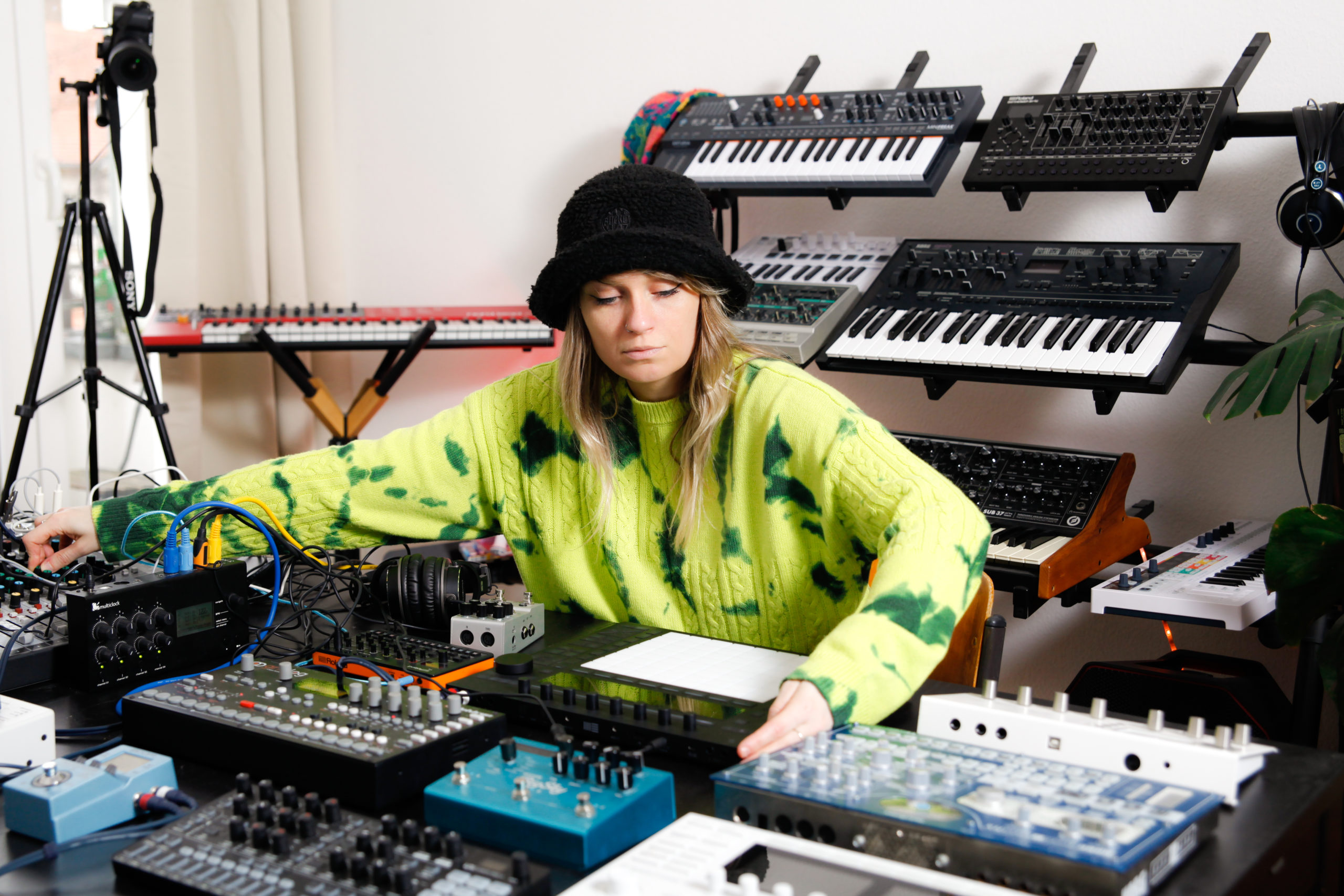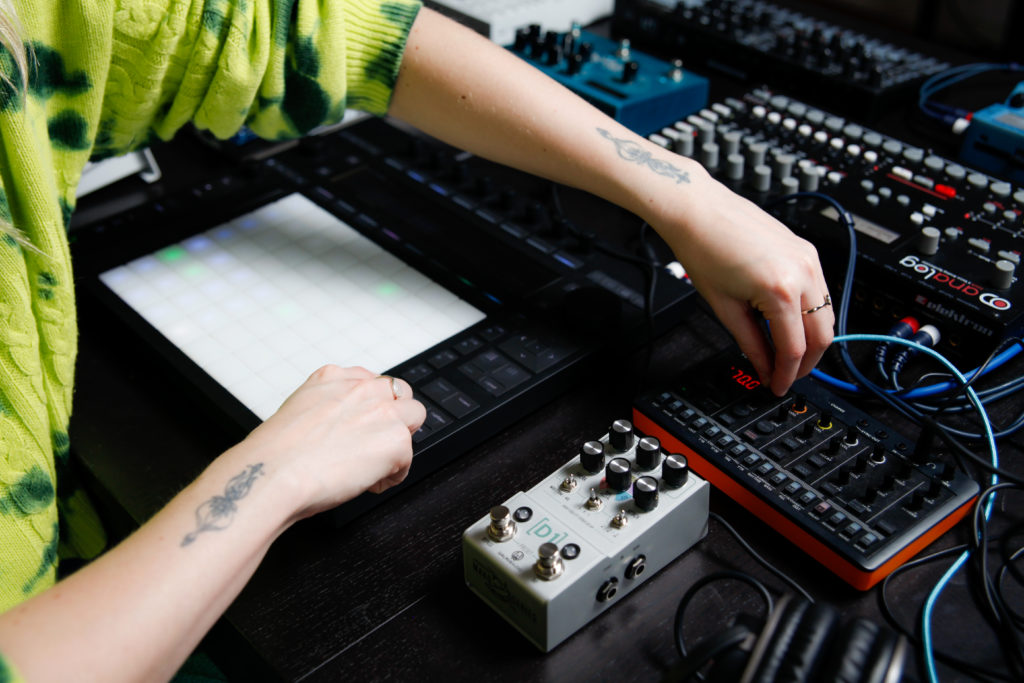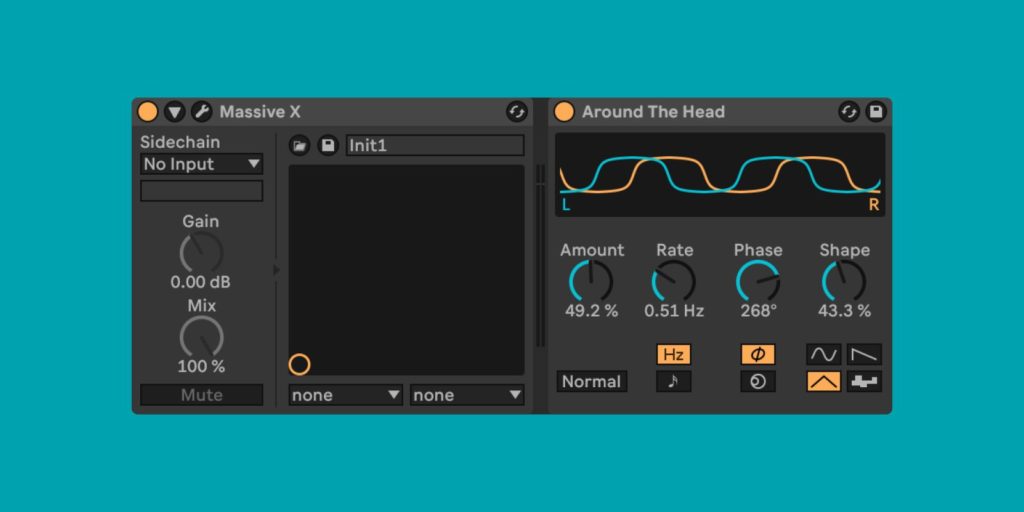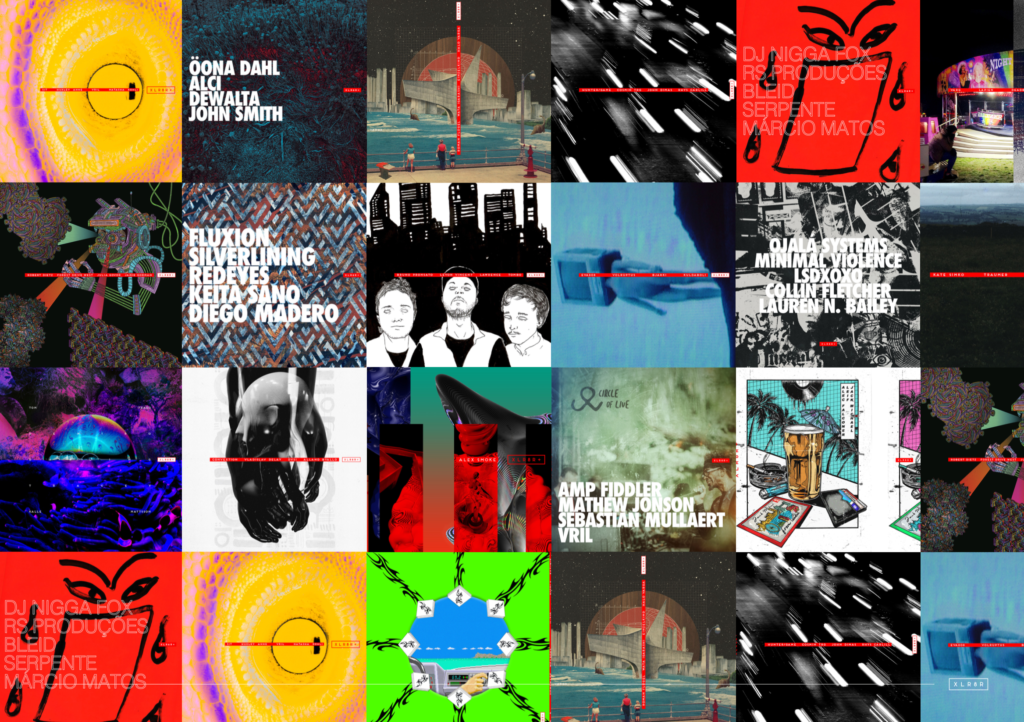Download an Ableton Live Set From Nadia Struiwigh
The multi-genre artist discusses her life in music and the production methods behind her new track, "Leelow Waters."

Download an Ableton Live Set From Nadia Struiwigh
The multi-genre artist discusses her life in music and the production methods behind her new track, "Leelow Waters."
In a world where conformity often reigns supreme, the pressure to neatly categorize and label our music into different genres can sometimes stifle creativity. However, for multifaceted artists like Nadia Struiwigh, these pressures serve as poignant reminders to assert individuality.
Drawing inspiration from the visual cues of her surroundings and the self-described fairylands of her imagination, Struiwigh crafts nuanced, eclectic compositions that exude elegance and defy categorization. Her genre-fluid output spanning techno, ambient, and electro, emerges as a unique blend of experimental electronica, which has found homes on esteemed labels such as Central Processing Unit, Nous’klaer Audio, and Dekmantel.
Beyond the studio, Struiwigh’s live sets and DJ performances traverse a full spectrum of sensibilities and styles. Hints of techno and drum and bass provide familiar footholds, only to be quickly swept away into the uncharted territories of her distinct auditory landscape.
In partnership with Ableton, we talked with Struiwigh about her life as an independent artist, and the technical and philosophical concepts underpinning her work. For an inside glimpse into her creative process, she has also shared the Live Set of her new track “Leelow Waters.”
Download the Live Set to Nadia Struiwigh’s track “Leelow Waters” here*
*Requires a Live 12 Suite license or the free trial.
Please note: This Live Set and included samples are for educational use only and cannot be used for commercial purposes.
Thank you for taking the time to speak with us today, Nadia. Can you tell us a bit about your background and what inspired your journey into music-making?
Sure, it all began when I was quite young. Instead of just listening to songs, I naturally perceived frequencies and began observing various elements in music. Like most teenagers, I reached that phase where I started going to parties and raves. One time I was raving and suddenly someone asked, “Hey do you maybe feel like DJing at our party.” I’d never DJed before so I said, “Err, yes sure.” I started making music quite soon after. My partner at the time had a laptop with Reason installed. I still remember the moment I took it onto my lap, in bed, and just started making a track with my headphones on.
What do you think has motivated you to keep creating music since?
If I don’t make music for a week I feel like I haven’t expressed myself. Like if I go on holiday, even though for a lot of people it’s amazing to go away for two or three weeks, I become super restless. I need to create. For me it’s a must just to have a release; a way to communicate with other people. Making music is basically my main language. If I need to express myself, sending someone a track to convey how I feel is better than using words.
Which other artists have inspired your work?
I grew up with Enya and Genesis, and there was Dire Straits from my Dad’s side. It was nice to grow up around that kind of music because it had soul; it came from the heart. They made music with the tools they had at the time. And now, even though we have AI and so on, it can never go there.
Later, I discovered more electronic music. I rode the Aphex Twin train. I was into Boards of Canada, Om Unit, and Debridge. Clarke was a big inspiration. Border Community was like a whole episode in my life. And James Holden’s work inspired me greatly. It showed me that experimental music is much more connected to the soul than we realize.
Would you describe the music you make today as experimental?
Years ago a good friend described my music as electronic soul. And I think that is it. But I make every genre because I think they are all a part of who we are. I don’t want to limit myself. If I’m feeling super energetic for example, that can be translated into an energetic techno track. But if I try to make a techno track just because I have a goal in my head to do so, within five minutes, I’ll know it isn’t going to work. This happened to me last night, so I switched to ambient, and it turned out to be one of the best pieces I’ve ever made. If you can really tap into your true self and the way you’re feeling in the moment, you’ll know exactly what kind of genre you want to make.
Do you encounter any challenges marketing yourself as a multi-genre artist?
Normally, once you’re stamped with a certain genre, whether it’s techno, EDM, or whatever, it’s easier to sell. But every time that happens to me, I pull myself back and say, “No, this is not all I am.” I don’t want to be associated solely with one kind of energy. I’ve had to work really hard to trust my own thinking and beliefs to be able to do this.
Did you ever have any formal music training?
No. But, when I was younger, if I heard a song I could immediately play it on a keyboard without even knowing which notes. They call it “absolute pitch,” so I can tune into scales easily. I’ve started to realize that in classical training, or any genre of schooling, they offer you methods to work with and express yourself, but I’ve developed my own methods. When I create music, I channel strong emotions. Last night, for example, I created an ambient track in just 30 minutes, because I was so in touch with what I was feeling. So, it’s not always about specific tools or techniques; it’s about what we feel. This is what I think about when I create my music. It’s not about individual elements like needing a kick, or needing that. No, it’s about the energy, the frequencies and the palette you will work with. It’s a universal language.
Can you recall any key moments or events that kick-started your music career?
I still know exactly when it happened. It was in 2017. I had been making my first album, Lenticular. Lenticular refers to the phenomenon where the surface of an object can appear different when you move it from left to right. It’s a cool way of looking at light. I have a big love for this because it shows how we can shift from one side to another and see something different. This is how I think people perceive life. We have these different filters. So that became the concept of the album. Anyway, I remember taking it along to the Ninja Tune ADE meet-up. I was one of three ladies participating in a demo drop. I was so shy. They put on my demo and I was like, “Omg they will burn me down.” But Peter from their A&R department came up to me and said, “Wow, who are you girl? Your music is something else, please keep doing that.” Luckily at the time a friend of mine was releasing music on CPU Records from Sheffield. Chris at CPU said to me, “Yeah let’s do it, let’s release this record.” I was jumping on my couch saying, “Is this really happening or am I too early? No, this is really happening!” At that time the label was really pumping, so the album got out there in all directions. An actor from The Wolf of Wall Street movie even reached out to say, “Your music is amazing! I listen to it every time I have to perform.” Someone at Ninja Tune also wrote and said, “I’d buy your records.”
After that, things started to flow. I got bookings. But then I became very ill for four years. I had to cancel everything. It was a horrible time. My whole life shifted, my friends shifted, and my perspective on life shifted. In the end, I’m happy that it happened because the younger me could not handle the music industry. I was saying yes to everything and it was exhausting. But now, I’m catching the wave again, I can feel it.
Have you always been in a position to pursue music full-time, or did there come a point where you had to take a leap and quit your day job?
A lot of people ask me this. It’s one of the hardest things. I bailed out of school to do music. I was that dedicated already. I was studying interior design and architecture but I was only submitting 2D projects, like videos with music. The teacher said, “Nadia, I don’t think this is the school for you if you want to do this.”
I went into freelancing because I knew my creative skills were my security system. If things didn’t work out with my music, I could rely on them. I taught myself how to be a web developer and a designer, and I’m writing now too.
I had separate email addresses for graphic design and music, and I noticed a shift – more emails were landing in my music inbox than in the graphic design one. I realized my music was gaining traction, allowing me to do less design work.
Then the pandemic hit and all my shows were wiped out. But I could still fall back on my other skills. When I lived in Australia I landed a job with Nikon as a brand designer, so I was always capable of getting those jobs. Eventually, I left my day job. But I had like zero in my bank account. So I had to ask myself, “OK, Nadia, what are you going to do?, because we need to earn money.” But I still took that leap of faith; even in those hard moments.
This year, after a long journey I’ve been able to let go of everything that I was tied to contractually. I just work for myself now. It’s crazy how much things can change in only two years if you just focus and believe in yourself.
You are also known for your passion for music gear. What were some of the influential factors that contributed to that?
While I was growing up my Dad worked in tech. He was employed at various companies in high-up positions. He would always come home with the latest gadgets, so it was programmed into my DNA to become a tech nerd I think. Instagram later became a platform where I could share my passion for music gear. My account grew super fast as I exchanged knowledge and built an online community around it.

Let’s look at the Live Set you’ve shared. Could you shed some light on the inspirations behind the track and its title, “Leelow Waters”?
When I make music, I often find myself immersed in a sort of fairyland—I’m not even fully present in the real world. I inhabit my own world filled with hopeful and inspiring creatures. That’s a bit reflective of who I am; I love Star Wars, Lord of the Rings, and all these sci-fi fantasy stories.
“Leelow Waters” is essentially one chapter in a fantasy concept I’ve been developing. All these names come to mind spontaneously—they just pop up. I could probably write a whole book about it because it’s like a vivid painting in my mind. Essentially, I’m painting the entire scenery with my music.
Is there any particular methodology underpinning the way you produced “Leelow Waters”?
I saw this project as an opportunity to refine my skills in software again. Sometimes I like to work in the box; it can enable my creativity in different ways. I’m usually quicker with hardware, but overall, this track just came together differently.
Drum Racks seem to play a significant role in the project. You’ve chosen some interesting kits with nuanced hits, noises, and textures.
Yes, I often use sounds from the Drum Racks in the Ableton Live library; because I feel you don’t always need to reinvent the wheel. Sometimes I like to create things from scratch; it feels therapeutic. But other times, I just want to compose. I want to find elements that resonate with my soul, and then I’m able to work quickly. I’m very quick with composing. I see it like painting. I start with a base coat and then add layers of color on top.
Do you ever hit creative blocks when composing and if so how do you overcome them?
I strongly believe in the power of deletion. Rather than getting stuck in a loop, I make the composition as full as possible, then step back and assess if anything needs to be removed or added back in. My tracks tend to be longer than shorter so another function I use in Ableton Live is “Delete Time” (CTRL/CMD + SHIFT + X). I love it.
The drum patterns in your track are intriguing. Where did you draw your inspiration for them?
There are several ways I do my drums. I have a Push 3 which I put on repeat mode, so I can just repeat and overdub different hits. And again, I’ll make the drum patterns really full at first and then I’ll delete things until they make sense.
I sometimes also convert a drum loop that I love into MIDI, so I have the groove but can use my own sounds.
Sometimes I just want to get inspiration and that’s what I love about Ableton Live 12. There are these new generative MIDI tools which you can get a lot of ideas from. Before I would just use my mouse to click some notes into the grid and just listen. But now it’s become a lot easier because of this whole new world of features.
Do you typically record your own finger-drumming on Push 3 to build up your patterns or do you prefer to use step sequencing?
In this track, I played most of the drums on Push 3 in real time and then copied the MIDI patterns onto other tracks. If you look at the tracks in my project called, DRUMS1 and DRUMS2 they’re the same MIDI parts but I’ve chosen different starting points to create a kind of polyrhythm.
On DRUMS2 I’ve used alternative sounds because even though it’s the same pattern it sounds totally different. Every sample has a different attack or release so the timing also shifts. It just creates this different groove. I love to play like that.
Also, if you look at the first Drum Rack, you’ll see the C1 cell is empty. This was where the kick was. But, I dragged and dropped that to a different channel. I always extract the kick because I want to have it clean. Then I can put a compressor on it to bump it up without affecting the rest of the drum kit.

Did Push 3 feature in any other parts of your music-making process?
I also used it for playing keys, such as with the Massive X pads, and for recording automation. Also, I use the Push to check how my tracks work live. I gather all the clips and elements I want to use, then use it as a live instrument. This allows me to think about how I can build the track in real time. Afterward, I go to the Arrangement View in Live to map out the structure. I also enjoy exploring scales with Push because, as I mentioned, it helps me understand what works and what doesn’t in real time. It allows me to click less and be more expressive and intuitive with hardware.

There are some interesting static and filtered noise elements in your track. What techniques do you use to create those types of sounds?
The thing with noise is, it fills up a big portion of the frequency spectrum and I feel like it keeps things interesting and not too loopy. That’s why I use noise textures a lot of the time. I believe there are two ways of working with noise. One is to embrace total randomness, where there isn’t necessarily a discernible pattern. The other involves creating a pattern out of noise, so it becomes like part of the percussion. You can hear this approach in tracks by artists like Alva Noto. He makes textures with subtle beeps and nuances that feel quite structured. What I often do now is have a noise element as a wav. file in my project. I then use the Beat warp algorithm in Live and the Transient Envelope function to create a rhythmic gating effect. I’m fascinated by the extent to which even the smallest sounds can have a significant impact.
You’ve used the Auto Pan effect on a lot of the tracks in your project, what is the reason behind that?
Yeah, I love it, I always use it. So if you think about it, we never perceive sounds as static; they’re always moving. Like if you hear a car coming by, its sound is directional. I aim to create that experience for people. If all my sounds remain static, it feels unnatural. This approach works particularly well with pads. When you add movement to them, they become like the ocean; like waves. So, it’s not just about the sound’s frequency; it’s also about its position in space. I almost always use the Auto Pan effect to create movement. It’s really easy to use and doesn’t eat too much CPU. I also use the ping-pong Delay because it adds a subtle back-and-forth motion to sounds. If everything is in the center, it becomes challenging to mix down your track because it results in a big ball of frequencies in one place.

When designing music for a club system there isn’t much scope for panning though, right?
It’s true, in a club environment, it’s usually all mono. This is why I always check my mix in mono. If it still works, I know it’s a good mix.
Nadia, thanks for talking to us today. Before you go, what’s on the horizon for you over the rest of 2024?
I’m launching my new label, Distorted Waves, which “Leelow Waters” is released on. There are a lot of shows coming up which I am grateful for; so summer will be pumping. Then I’m going to branch out with the music school that I am building. I’m already in the process of bringing it to fruition. Releasing-wise, hopefully, a second album and lots of collaborations are coming. I think this is a flying year and I’m happily flying with it.

